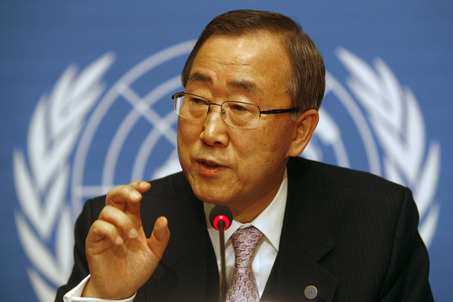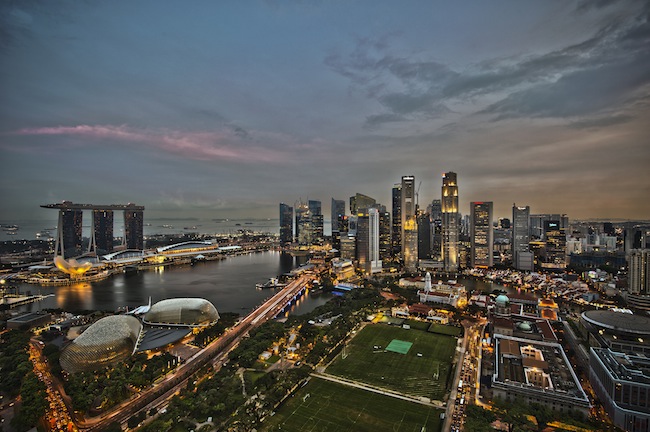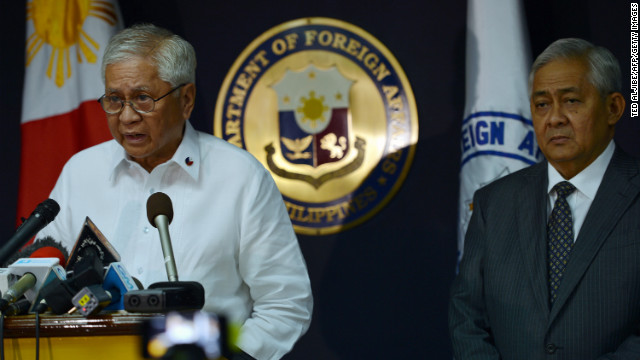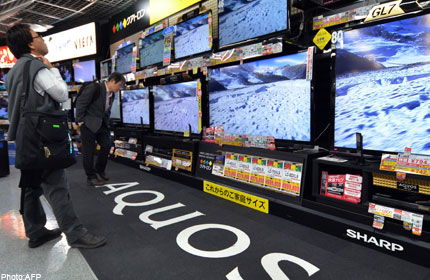UN leader Ban Ki-moon on Tuesday called for an "amicable" settlement to a mounting South China Sea territorial dispute between China and other Asian nations.
Asked about the Philippines' decision to refer the case to a UN tribunal, Ban told reporters he has been following the dispute "carefully".
"It is important for those countries in the region to resolve all these issues through dialogue in a peaceful and amicable way," he said.
The United Nations is ready "to provide technical and professional assistance, but primarily all these issues should be resolved by the parties concerned," the UN leader added, carefully avoiding backing any country involved.
China, the Philippines, Brunei, Malaysia, Vietnam and Taiwan all have overlapping claims to the territory.
The Philippine government announced Tuesday that it would ask an arbitration panel under the UN Convention on the Law of the Sea - a 1982 treaty signed by both countries - to rule on China's claims.
Philippine Foreign Secretary Albert del Rosario said, "The Philippines has exhausted almost all political and diplomatic avenues for a peaceful negotiated settlement of its maritime dispute with China."
Over the past two years the Philippines and Vietnam have complained at China's increasing assertiveness in enforcing its claims, particularly in areas believed rich in oil and natural gas reserves.
China has said the rival claims should be settled through negotiations.-Interaksyon (January 23, 2013 4:05AM)
Singapore on Monday, January 21, announced increased cash bonuses for parents of newborn babies and introduced paternity leave as part of a package of measures to boost population and reduce dependence on foreigners.
Parents of Singaporean babies born since August 26 last year will receive a cash gift of Sg$6,000 ($4,900) -- a rise of 50 percent, which applies to each of a couple's first two children.
The financial incentive will rise to Sg$8,000 for a couple's third and fourth babies, as the government attempts to offset the high cost of raising a family -- one of the gripes often aired by young couples in the city-state.
At least one parent must be a Singapore citizen to be eligible for the handout.
The government will subsidise one week of paternity leave for fathers of babies born from May 1 this year, the National Population and Talent Division (NPTD) agency also announced in a press release.
In addition, new fathers will be eligible to stay off work for a second week by taking a chunk of the standard 16-week maternity leave granted to their wives, it added.
Housing issues were also addressed in the Sg$2 billion ($1.63 billion) Marriage and Parenthood Package.
Couples with at least one child below 16 will be given priority to buy government-built apartments, where most Singaporeans live. Many couples keep their families small until they get their own flats.
"We hope that the enhanced marriage and parenthood measures will help create a more conducive environment for Singaporeans to set up families," Deputy Prime Minister Teo Chee Hean said in the press release.
Singapore's birth rate of 1.20 children per woman, according to 2011 figures, is well below the 2.1 figure needed to sustain the native population.
The low rate has forced the city-state to bring in more immigrants in recent years. But the numbers were reduced following a social backlash, with foreigners blamed for problems including overcrowding, straining public services and driving up housing costs.
Singapore, which relies on foreign labour to power its economic growth, now has a population of 5.3 million, of whom only 3.3 million are citizens.
By 2030, 20 percent of Singaporeans are forecast to be 65 years or older, according to official statistics. - Rappler (January 22, 2013)
The Philippines raised the stakes in its maritime territorial dispute with China by announcing Tuesday it is taking the case to an international tribunal.
The two Asian nations have been at loggerheads over China's claims of sovereignty over large swathes of the South China Sea, one of several tense disagreements between Beijing and its neighbors over waters in the region.
"The Philippines has exhausted almost all political and diplomatic avenues for a peaceful negotiated settlement of its maritime dispute with China," Philippine Foreign Minister Albert del Rosario said Tuesday.
As a result, Manila is challenging China's claims, which include the waters off the west coast of the Philippines, at an international arbitration tribunal, citing the United Nations Convention on the Law of the Sea.
Read more: Asean Chief: South China Sea risks becoming 'Asia's Palestine'
The state-run Chinese news agency reported the announcement by the Philippines on Tuesday but didn't carry an immediate response from Beijing.
Other countries, like Vietnam and Malaysia, also lay claim to parts of the South China Sea, a 1.3 million square-mile patch of the Pacific Ocean dotted with hundreds of largely uninhabited islands and coral atolls.
The area is a fertile fishing ground and is believed to hold large oil and gas reserves under its seabed.
Tensions between China and the Philippines soared last year during a naval standoff over a remote rocky outcrop in a disputed part of the sea. That crisis lasted months and stoked fears of an open conflict before the Philippines withdrew its ships, citing stormy weather.
Analysts say China is trying to solidify its claims of "indisputable sovereignty" over most of the South China Sea by conducting regular maritime patrols in the area.
It is using a similar approach in its heated dispute with Japan over set of small islands in the East China Sea.
The United States is treading a delicate path amid the various territorial tensions in the region.
On Sunday, Chinese Foreign Ministry Spokesman Qin Gang warned United States to "be careful with its words" after Secretary of State Hillary Clinton said Washington opposes "any unilateral actions that would seek to undermine Japanese administration" of the disputed islands in the East China Sea.
Clinton had reiterated the U.S. policy that it doesn't take a position on the ultimate sovereignty of the islands.
As recently as last week, Xinhua reported that Chinese surveillance vessels were carrying out regular missions in the South China Sea.
The Xinhua report cited Liu Cigui, director of the State Oceanic Administration, as saying that China would continue the patrols "to secure the nation's maritime rights and interests" in areas it claims as its territorial waters.-Cable News Network (January 23, 2013)
The Iranian government has confirmed reports that it is preparing to open an embassy here, with a spokesman saying initial preparations have already been made.
The spokesman told news agencies that Iran had initiated discussions on opening the embassy.
Myanmar has diplomatic relations with 110 of the 193 member countries of the United Nations. The United States restored full diplomatic relations with Myanmar last year following democratic reforms. Twenty-eight countries now have embassies here, with embassy staff saying that some are quickly expanding their commercial affairs departments to handle a surge in interest in business opportunities.-Asia News Network (January 22, 2013)
The constant evolution and innovation in the world of TV technology have been successfully fueling consumer demand and driving consistent growth in the industry over the last few years. In the Southeast Asia region, flat panel TVs have continued to register a surge in demand in 2012, selling over 8.3 million units in the first eleven months of the year and reflecting a 26 per cent volume growth over the same period the previous year.
LCD is the most sought after TV type across the region, making up more than nine out of ten sets purchased by Southeast Asian consumers. Four of the six markets tracked by GfK - Malaysia, Vietnam, Thailand and Indonesia registered 10 to 70 per cent spike in sales quantity of LCD TV in the respective countries.
"The total LCD TV market across the region increased by 13 per cent over last year, spurred largely by the strong demand of LED TVs which contributed to a significant chunk of the LCD TV pie," said Gerard Tan, Account Director for Digital Technology, GfK Asia. "The developing countries are getting more exposed to the advantages of this newer TV technology and its consumers are increasingly demanding for it."
Indonesia is the largest and also fastest growing market, thanks to the population's ongoing high rate of conversion from the traditional CRT TV. Nearly 2.9 million sets of LCD TVs were sold in January to November 2012; 68 per cent more than a year ago. While in the Singapore market on the other hand, 77 per cent of all flat panel TVs sold were LED TVs with the rest being Plasma TVs.
"Consumers in the region are willing to splurge on TVs, having spent over USD 3 billion on LCD TVs last year-13 per cent more compared to the year before," highlighted Tan. "One of the key drivers of the strong sales is greater affordability due to price erosion attributed to keen competition among major brands, and the introduction of more advanced technologies, for instance, Internet-content, 3D etc."
According to findings, Internet-content and 3D TVs are progressively gaining grounds with all the six markets reflecting sales growth. While one in every ten (11%) sets of TV sold in the region last year had the Internet content feature, 3D TVs formed around 7 per cent of all flat screen TV sales.
"The latest cutting edge TV technologies introduced by major brands are the 4K and OLED TVs which received much attention during the recent Consumer Electronics Show," highlighted Tan. "However, with the current economic outlook in the region, consumers are likely to be exercising more caution in spending on big ticket items such as these upmarket TVs. Nevertheless, we foresee the overall TV market to continue remaining buoyant in 2013, attributable to the continued switchover process in the developing markets," he concluded.-Asia One (January 22, 2013)
A 5.9-magnitude earthquake struck off Indonesia's Aceh province on Tuesday, killing an eight-year-old girl and injuring seven others, officials said.
The quake struck 112 kilometers southeast of the provincial capital of Banda Aceh at 22:22 GMT, at a depth of 37 kilometers, the US Geological Survey said.
"An eight-year-old girl in Pidie district was killed after a cupboard in her bedroom fell on her when the quake shook the ground," the district's disaster management agency chief Apriyadi, who goes by one name, told AFP.
He added that seven people were injured, four of them seriously, due to collapsing walls.
The Indonesian Meteorology, Geophysics and Climatology Agency (BMKG) issued no tsunami alert.
Indonesia sits on the Pacific "Ring of Fire" where continental plates collide, causing frequent seismic and volcanic activity.-The Jakarta Globe (January 22, 2013)
Amid rising tensions with Japan over disputed islands, Chinese army in a bid to scale up battle readiness has ordered its armed helicopters to shift focus from logistic missions and gear up for combat operations.
The People's Liberation Army (PLA) planned to change the training strategy of its army aviation unit as more and more armed helicopters joined the service, PLA Daily which is the official newspaper of the military quoted an army aviation unit as saying.
The focus of army aviation unit will be shifted from logistics missions to combat ones, from building the capacity for non-war military actions to core military actions, state-run Xinhua news agency quoted the daily as saying.
The unit will work on major missions such as long-distance tasks, large scale offshore operations, attack coordination with other units and large scale airborne operations, it said, adding that the unit will also aim to improve its operation capability based on IT technologies.
Both China and Japan have scaled up military operations after the escalation of the dispute over the islands called Diaoyu by China and Senkakus by Japan.
The PLA move comes in the backdrop of recent military drills conducted by the Japanese army helicopters to defend the islands from enemy raids.
Chinese military exercises in recent months involving ships and aircraft focused on taking the islands and retaining them.
While naval ships of both the countries patrolled the waters of the islands, the two also scrambled aircraft last week to intercept surveillance planes.
Conflict over the islands escalated after Japan, which retained the administrative control over the islands bought them from a private party.
Objecting the move, China sent its ships into the island waters. On January 15, General Staff Headquarters of the PLA had asked commanders and soldiers to strengthen their readiness for possible war with a directive to stage more exercises.
“The General Staff Headquarters of PLA has pledged to stage more military drills that simulate real combat, urging commanders and soldiers to strengthen their readiness for possible war,” the PLA Daily reported.-Deccan Herald (January 21, 2013)
The Zest-O group is eyeing to expand its manufacturing footprint across Asia, enabling the beverage firm to tap the huge population of booming economies in the region.
Former ambassador Alfredo Yao, Zest-O chairman, said the company is in talks to build manufacturing plants in China and Myanmar, with the benchmark investment for each facility expected to reach P250 million.
"We may spend more in Myanmar because we are thinking of [putting up] a bottling company there. We are following what we did here with RC Cola," Yao said.
Myanmar is on the brink of economic resurgence as it opens up to foreign investment and trade following decades of military rule. Zest-O is among those seeking a piece of what can be a very lucrative market.
"Galing ‘yan [Myanmar] sa embargo. Like you're pouring water in the dessert area," said Yao.
Zest-O has production plants in the Middle East and Indonesia, with operations abroad accounting for less than a tenth of the company's total business. It exports products to China, Indonesia, Vietnam, the Middle East, and the United States.
As exports become more expensive, Zest-O will focus on expanding its manufacturing presence overseas, said Yao, adding that the company employed a strategy of initially testing offshore markets through exports before expanding its operations there.
“This year, we will be doing good overseas. Our China operations will be okay. We’re just starting but it will have a snowball effect,” said Yao.
Aside from flagship Zest-O, the company markets Sunglo and Big 250 juice drinks as well as carbonated drinks and fruit sodas under the RC Cola, Zest-O-Cola, Rootbeer, and Twist brands. The company also offers health drinks under the One brand.
"It's the same product. We have to change a little of the packaging. We have to change the flavor and make some adjustments," said Yao, adding that Zest-O’s domestic business continues to grow and is seen to expand by double digits this year.
Established in 1981 as Semexco Markting Corp, Zest-O pioneered the first ready-to-drink juice in flexible foil pouch. The company operates five manufacturing plants in the Philippines and employs approximately 100 personnel for each facility.-Interaksyon (January 21, 2013 5:21PM)
Representatives of the ten ASEAN nations met on Sunday in Laos, capital of Vientiane, to launch the ASEAN Tourism Forum (ATF), where they pledged to expand tourism cooperation and discussed creating a pan-ASEAN tourist visa.
The ATF, which was first held in 1981, is designed to facilitate and develop tourism promotion and cooperation across the region. A total of 150 tourism ministers and officials from Brunei, Cambodia, Indonesia, Lao PDR, Malaysia, Myanmar, the Philippines, Singapore, Thailand and Vietnam attended the meeting.
Joining them will be 1,450 delegates, including 800 ASEAN exhibitors, 400 international buyers, 150 international and local media as well as 100 tourism trade visitors. Delegates will engage in bilateral talks, sellers and buyers meetings, and receive presentations from various ASEAN nations on their tourism industries.
According to a press release from the ATF, ASEAN leaders will consider the possibility of creating a single pan-ASEAN visa for some member countries to encourage tourists to visit. Leaders have already agreed to put more funding into developing tourism, source more financing from dialogue partners, and to promote tourism in the region.
"As an important economic sector, ASEAN cooperation in tourism has gone from strength to strength," said Lao Minister of Information, Culture, and Tourism Dr Bosengkham Vongdara. Vongdara cited the increase in total international visitors arriving in the region from 73.7 million people in 2010 to 81.2 million in 2011 as evidence of this cooperation.
Tourism is of particular significance to Laos, one of the least developed countries in South East Asia with few domestic industries. With a population of only 6.3 million people, Laos received approximately half this figure in tourist arrivals in 2012. This contributed significantly to economic growth and development in the country. Arrivals are expected to reach five million by 2015.
Across the various ASEAN member nations, tourism has risen between eight and 29 percent from 2010 2011. The ATF will run from Jan. 18 24.-Philippines News Agency (January 21, 2013)
Three Chinese government ships were in waters around islands at the center of a dispute with Tokyo on Monday, the day after China issued a rebuke to the US over comments seen as supporting Japan.
Japan’s coastguard said the maritime surveillance boats were in waters around a chain of Tokyo-controlled islands known as the Senkakus in Japan, which Beijing calls the Diaoyus.
China has repeatedly sent ships to the area since Japan nationalized some of the chain in September, a move that triggered a diplomatic dispute and huge anti-Japan demonstrations across China.
Beijing has also sent air patrols to the archipelago in the East China Sea, and in recent weeks both Beijing and Tokyo have scrambled fighter jets, though there have been no clashes.
On Sunday, Beijing said it was “strong dissatisfied” after US Secretary of State Hillary Clinton issued a veiled warning to China not to challenge Tokyo’s control over the chain, which is believed to sit atop vast mineral reserves.
On Friday, Clinton said the US opposed “any unilateral actions that would seek to undermine Japanese administration” of the islands.
The top US diplomat added “we do not want to see any action taken by anyone that could raise tensions or result in miscalculation that would undermine the peace, security and economic growth in this region”.-Philippine Daily Inquirer (January 21, 2013 10:13AM)
The Philippines is the “most romantic destination” for Chinese paper Shanghai Morning Post, the Department of Foreign Affairs (DFA) announced Monday.
The DFA said that the "Most Romantic Destination" award was given to the Philippines through the DFA's representative last January 15 at the Shanghai Peninsula Hotel.
The award was based on a consumer survey by the Shanghai Morning Post.
Philippine Consul General Charles Jose received the award from Liu Sha, the Chinese paper's Editor-in-Chief.
The DFA said that the other country-winners were: Australia as “The Best Tour Destination for Discovery;” Switzerland as “The Best Shopping Paradise;” Korea as “The Best Skiing Destination;” and Germany as “The Best Destination for Art Appreciation.”
The Philippines has also been awarded "Best Tourist Destination" by another Chinese newspaper, the Oriental Morning Post, last January 9.
The DFA said that it is expecting more Chinese to fly to the Philippines for the upcoming week-long Chinese New Year holiday in February, which is also Valentine's Day month.
It said that several Philippine carriers have re-launched flight services from China to the Philippines because of the increasing demand of Chinese travelers for short-haul beach holidays.-The Philippine Star (January 21, 2013 11:37AM)











